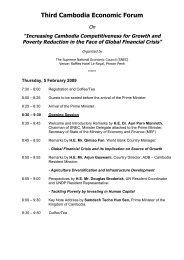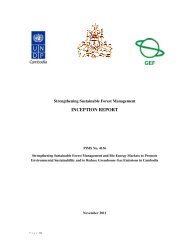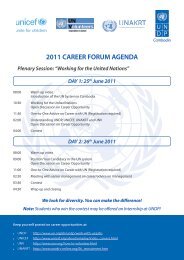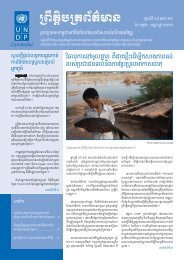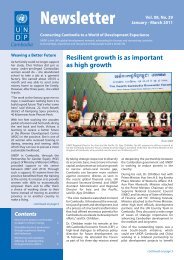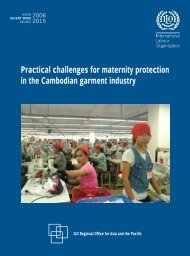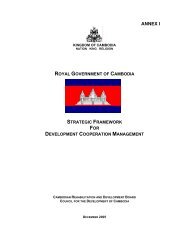UN Analysis Final.pdf - United Nations in Cambodia
UN Analysis Final.pdf - United Nations in Cambodia
UN Analysis Final.pdf - United Nations in Cambodia
Create successful ePaper yourself
Turn your PDF publications into a flip-book with our unique Google optimized e-Paper software.
Limitations <strong>in</strong> human capital are fundamentally <strong>in</strong>adequate for susta<strong>in</strong>ed economic growth, stable<br />
democratic <strong>in</strong>stitutions and poverty reduction <strong>in</strong> <strong>Cambodia</strong> . Poverty, economic shocks, and school<strong>in</strong>g<br />
quality force many young people to leave school without acquir<strong>in</strong>g the basic skills they need for work and life.<br />
Allow<strong>in</strong>g these youths to rema<strong>in</strong> illiterate or semi-literate and unskilled throughout their lives is costly to<br />
them, their families and to the nation as a whole.<br />
The provision of education is one of the best options to l<strong>in</strong>k youth to decent employment opportunities, lift<br />
their future livelihoods and reduce their vulnerability. To <strong>in</strong>clude and re<strong>in</strong>tegrate early school-leavers, MoEYS<br />
now operates adult literacy programmes that teach not only read<strong>in</strong>g, writ<strong>in</strong>g and arithmetic, but also job and<br />
life skills relevant to local contexts (ESSP 2006) (Box 4-6). The balance and sequenc<strong>in</strong>g of education policies<br />
across the three dimensions – post primary education opportunities, tools to enhance education decision<br />
mak<strong>in</strong>g, and second-chance education options – as well as prioritization among them (basic skills rather than<br />
post-basic skills) depends on the state of the education system (how it performs <strong>in</strong> prepar<strong>in</strong>g youth for work<br />
and life), its level of development, its overall development priorities, and the priorities of its young people.<br />
In this context, vocational tra<strong>in</strong><strong>in</strong>g programmes for out-of-school youth can be also more cost effective when<br />
tra<strong>in</strong><strong>in</strong>g is targeted and tailored to the needs of the local labour markets. Vocational tra<strong>in</strong><strong>in</strong>g is most effective<br />
for higher earners than lower earners illustrat<strong>in</strong>g the complementarity of vocational and academic skills.<br />
BOX 4-6: YO<strong>UN</strong>G PEOPLE WHO ARE OUT-OF-SCHOOL AND EQUIVALENCY PROGRAMMES<br />
To appeal to out of-school youth, there is need to take <strong>in</strong>to account why young people have dropped out<br />
or never attended school, the challenges they will face <strong>in</strong> order to stay <strong>in</strong> a programme, and how they can<br />
be <strong>in</strong>tegrated <strong>in</strong>to the formal education sector or f<strong>in</strong>d employment. All these vary by age, skill and the local<br />
environment. Equivalency, literacy, and job tra<strong>in</strong><strong>in</strong>g programmes may serve different youth populations,<br />
but their common aim of provid<strong>in</strong>g competencies for work and life requires a more <strong>in</strong>tegrated approach:<br />
literacy and equivalency programmes that <strong>in</strong>clude life skills and vocational tra<strong>in</strong><strong>in</strong>g, and vocational<br />
tra<strong>in</strong><strong>in</strong>g programmes that also <strong>in</strong>clude life skills. Equivalency systems use more practical curricula, more flexible<br />
schedules, and less formal <strong>in</strong>struction methods than regular schools. They depend on a strong partnership<br />
between the formal education sector, private providers of programmes, and prospective employers.<br />
Without this partnership, the graduates of equivalency systems will be left hold<strong>in</strong>g diplomas that allow neither<br />
re<strong>in</strong>tegration <strong>in</strong>to the regular school system nor employment <strong>in</strong> jobs requir<strong>in</strong>g a certa<strong>in</strong> level of competency.<br />
The mode of delivery must take <strong>in</strong>to account why young people have dropped out. Know<strong>in</strong>g that even small<br />
costs can be a barrier to enrolment for the poorest, successful programmes provide textbooks, notebooks<br />
and pencils.<br />
Successful equivalency programs that hope to re<strong>in</strong>tegrate people <strong>in</strong>to the formal education system often<br />
use teach<strong>in</strong>g methods that are similar to those recommended above for formal schools - student-centered<br />
learn<strong>in</strong>g, regular assessment and remedial sessions to <strong>in</strong>volve students <strong>in</strong> their learn<strong>in</strong>g progress. Programmes<br />
for older youth, however, often use very different approaches.<br />
Source: ESSP 2006<br />
Situation <strong>Analysis</strong> of Youth <strong>in</strong> <strong>Cambodia</strong><br />
49




